BM522 Project Management: Bucks Students' Union Music Fest Report
VerifiedAdded on 2022/08/15
|16
|2227
|15
Report
AI Summary
This report presents a comprehensive analysis of project management principles applied to the Bucks Students' Union Music Festival. It begins by comparing three project management methodologies: the waterfall model, adaptive project framework, and agile framework, outlining their advantages and disadvantages. The report then includes a network diagram, stakeholder analysis, and a work breakdown structure to illustrate project organization and stakeholder relationships. A detailed risk analysis is conducted, identifying potential risks, their likelihood and impact, and proposing mitigation strategies. The analysis covers various risk types including scheduling, budget, and change management risks. The report concludes by emphasizing the importance of risk management processes, including risk identification, analysis, evaluation, treatment, and monitoring. The report is designed to demonstrate a strong understanding of project management theory and its practical application.
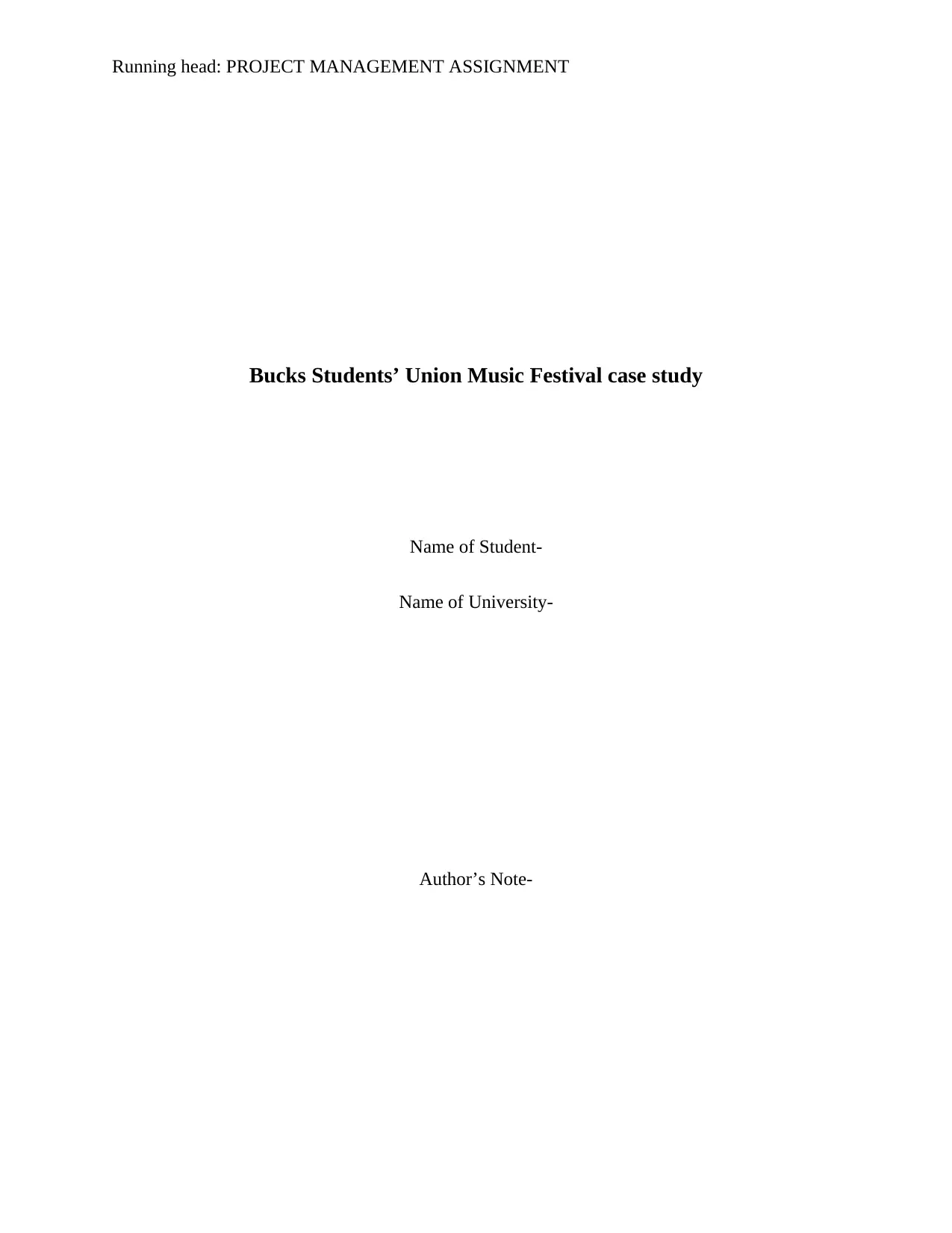
Running head: PROJECT MANAGEMENT ASSIGNMENT
Bucks Students’ Union Music Festival case study
Name of Student-
Name of University-
Author’s Note-
Bucks Students’ Union Music Festival case study
Name of Student-
Name of University-
Author’s Note-
Paraphrase This Document
Need a fresh take? Get an instant paraphrase of this document with our AI Paraphraser
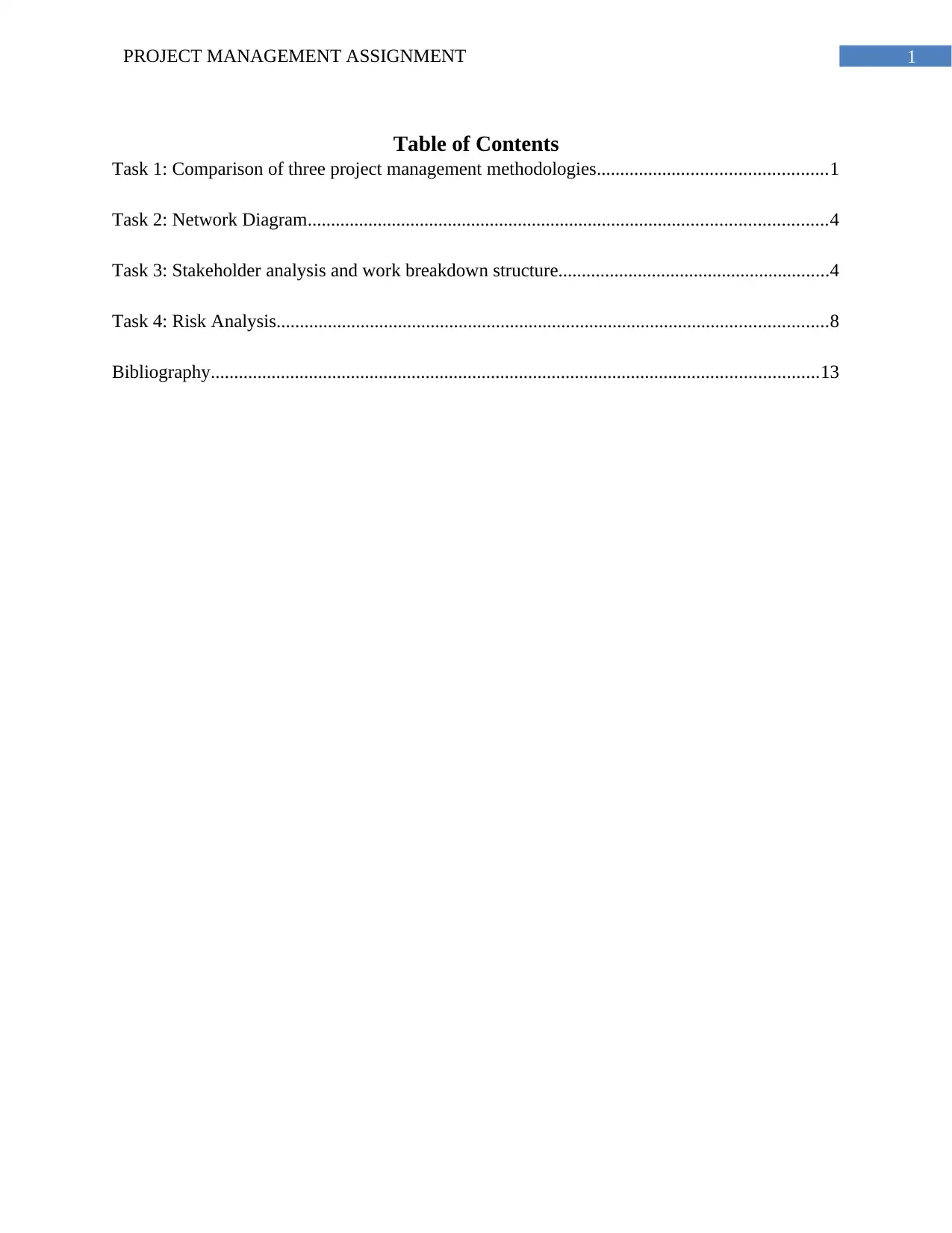
1PROJECT MANAGEMENT ASSIGNMENT
Table of Contents
Task 1: Comparison of three project management methodologies.................................................1
Task 2: Network Diagram...............................................................................................................4
Task 3: Stakeholder analysis and work breakdown structure..........................................................4
Task 4: Risk Analysis......................................................................................................................8
Bibliography..................................................................................................................................13
Table of Contents
Task 1: Comparison of three project management methodologies.................................................1
Task 2: Network Diagram...............................................................................................................4
Task 3: Stakeholder analysis and work breakdown structure..........................................................4
Task 4: Risk Analysis......................................................................................................................8
Bibliography..................................................................................................................................13
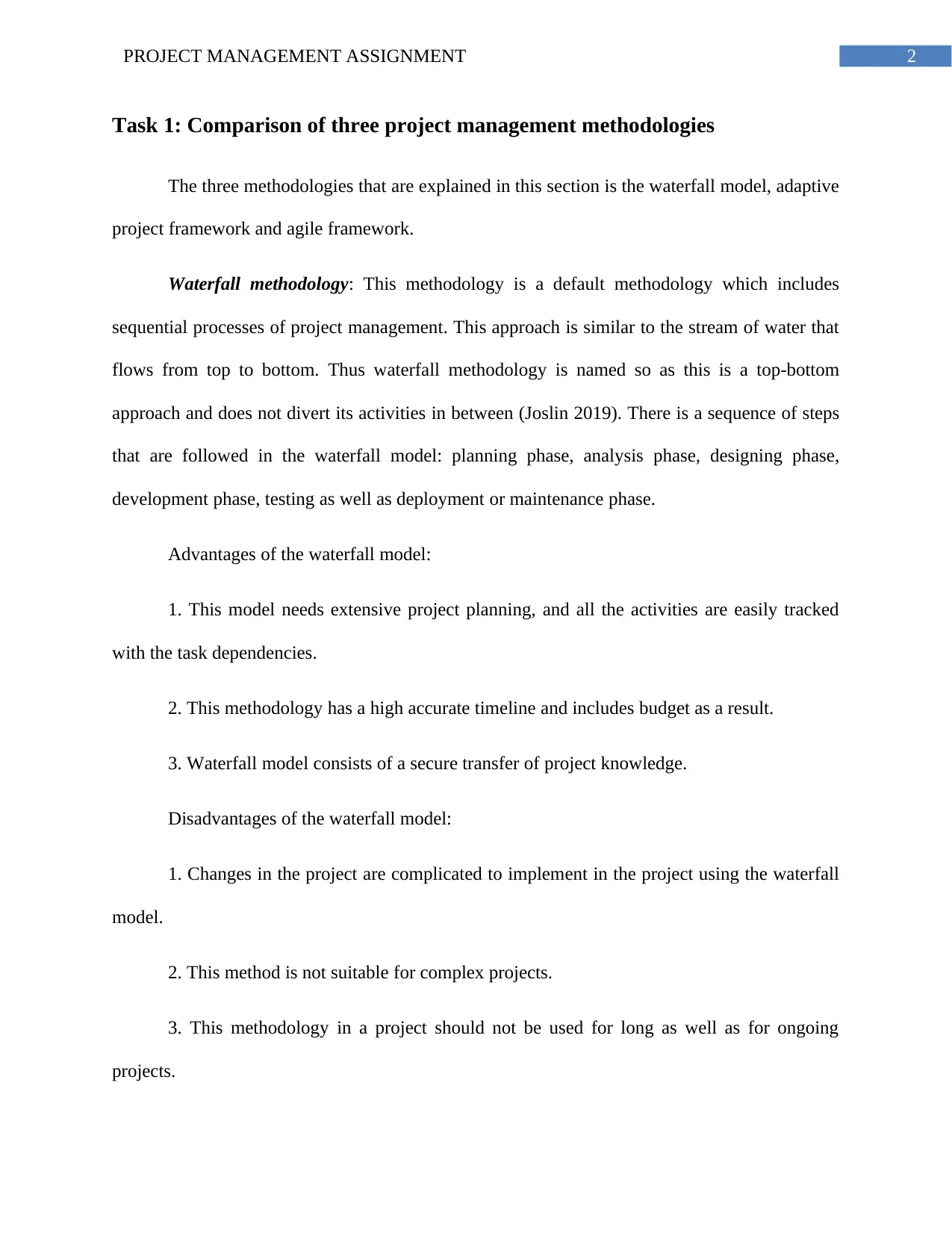
2PROJECT MANAGEMENT ASSIGNMENT
Task 1: Comparison of three project management methodologies
The three methodologies that are explained in this section is the waterfall model, adaptive
project framework and agile framework.
Waterfall methodology: This methodology is a default methodology which includes
sequential processes of project management. This approach is similar to the stream of water that
flows from top to bottom. Thus waterfall methodology is named so as this is a top-bottom
approach and does not divert its activities in between (Joslin 2019). There is a sequence of steps
that are followed in the waterfall model: planning phase, analysis phase, designing phase,
development phase, testing as well as deployment or maintenance phase.
Advantages of the waterfall model:
1. This model needs extensive project planning, and all the activities are easily tracked
with the task dependencies.
2. This methodology has a high accurate timeline and includes budget as a result.
3. Waterfall model consists of a secure transfer of project knowledge.
Disadvantages of the waterfall model:
1. Changes in the project are complicated to implement in the project using the waterfall
model.
2. This method is not suitable for complex projects.
3. This methodology in a project should not be used for long as well as for ongoing
projects.
Task 1: Comparison of three project management methodologies
The three methodologies that are explained in this section is the waterfall model, adaptive
project framework and agile framework.
Waterfall methodology: This methodology is a default methodology which includes
sequential processes of project management. This approach is similar to the stream of water that
flows from top to bottom. Thus waterfall methodology is named so as this is a top-bottom
approach and does not divert its activities in between (Joslin 2019). There is a sequence of steps
that are followed in the waterfall model: planning phase, analysis phase, designing phase,
development phase, testing as well as deployment or maintenance phase.
Advantages of the waterfall model:
1. This model needs extensive project planning, and all the activities are easily tracked
with the task dependencies.
2. This methodology has a high accurate timeline and includes budget as a result.
3. Waterfall model consists of a secure transfer of project knowledge.
Disadvantages of the waterfall model:
1. Changes in the project are complicated to implement in the project using the waterfall
model.
2. This method is not suitable for complex projects.
3. This methodology in a project should not be used for long as well as for ongoing
projects.
⊘ This is a preview!⊘
Do you want full access?
Subscribe today to unlock all pages.

Trusted by 1+ million students worldwide
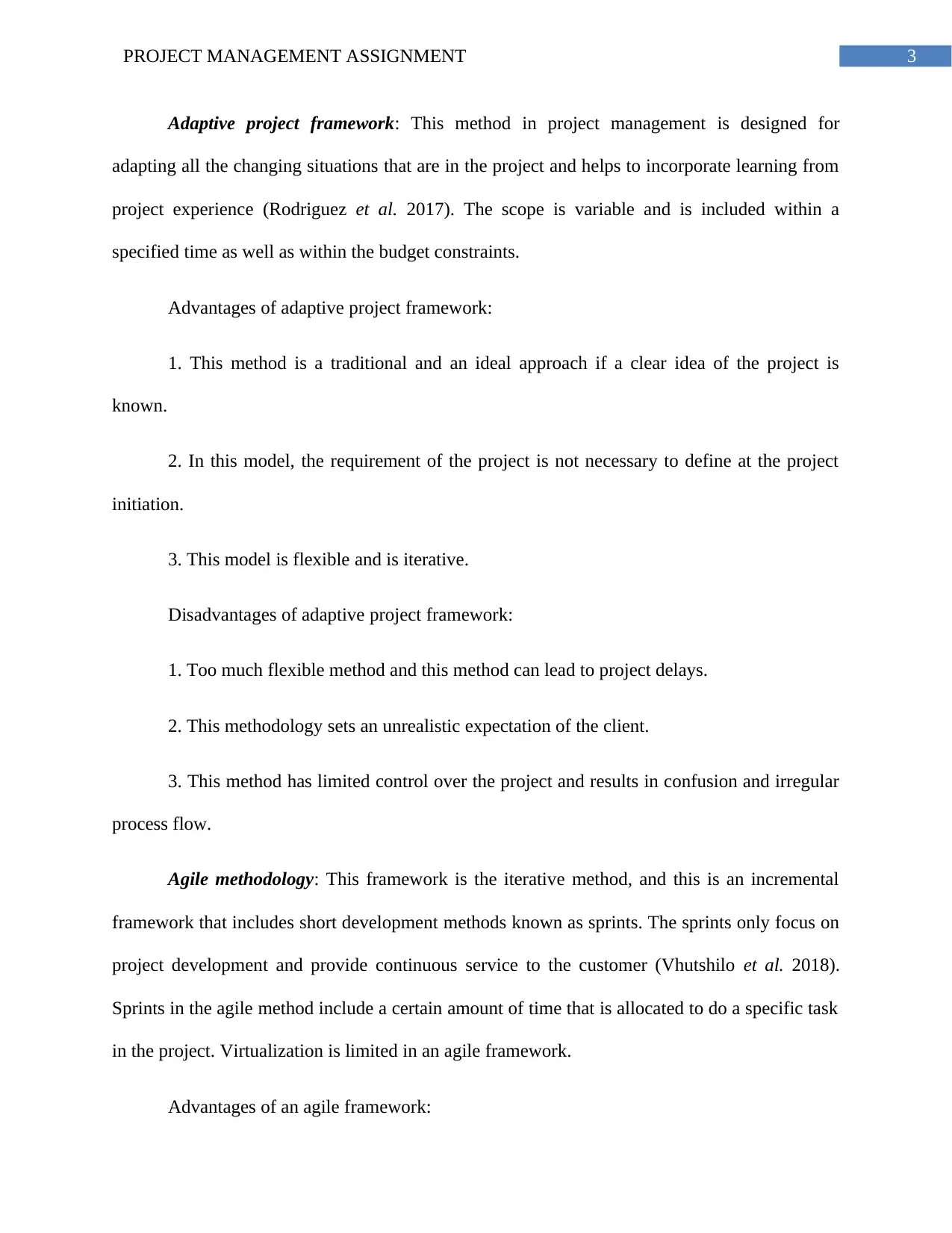
3PROJECT MANAGEMENT ASSIGNMENT
Adaptive project framework: This method in project management is designed for
adapting all the changing situations that are in the project and helps to incorporate learning from
project experience (Rodriguez et al. 2017). The scope is variable and is included within a
specified time as well as within the budget constraints.
Advantages of adaptive project framework:
1. This method is a traditional and an ideal approach if a clear idea of the project is
known.
2. In this model, the requirement of the project is not necessary to define at the project
initiation.
3. This model is flexible and is iterative.
Disadvantages of adaptive project framework:
1. Too much flexible method and this method can lead to project delays.
2. This methodology sets an unrealistic expectation of the client.
3. This method has limited control over the project and results in confusion and irregular
process flow.
Agile methodology: This framework is the iterative method, and this is an incremental
framework that includes short development methods known as sprints. The sprints only focus on
project development and provide continuous service to the customer (Vhutshilo et al. 2018).
Sprints in the agile method include a certain amount of time that is allocated to do a specific task
in the project. Virtualization is limited in an agile framework.
Advantages of an agile framework:
Adaptive project framework: This method in project management is designed for
adapting all the changing situations that are in the project and helps to incorporate learning from
project experience (Rodriguez et al. 2017). The scope is variable and is included within a
specified time as well as within the budget constraints.
Advantages of adaptive project framework:
1. This method is a traditional and an ideal approach if a clear idea of the project is
known.
2. In this model, the requirement of the project is not necessary to define at the project
initiation.
3. This model is flexible and is iterative.
Disadvantages of adaptive project framework:
1. Too much flexible method and this method can lead to project delays.
2. This methodology sets an unrealistic expectation of the client.
3. This method has limited control over the project and results in confusion and irregular
process flow.
Agile methodology: This framework is the iterative method, and this is an incremental
framework that includes short development methods known as sprints. The sprints only focus on
project development and provide continuous service to the customer (Vhutshilo et al. 2018).
Sprints in the agile method include a certain amount of time that is allocated to do a specific task
in the project. Virtualization is limited in an agile framework.
Advantages of an agile framework:
Paraphrase This Document
Need a fresh take? Get an instant paraphrase of this document with our AI Paraphraser
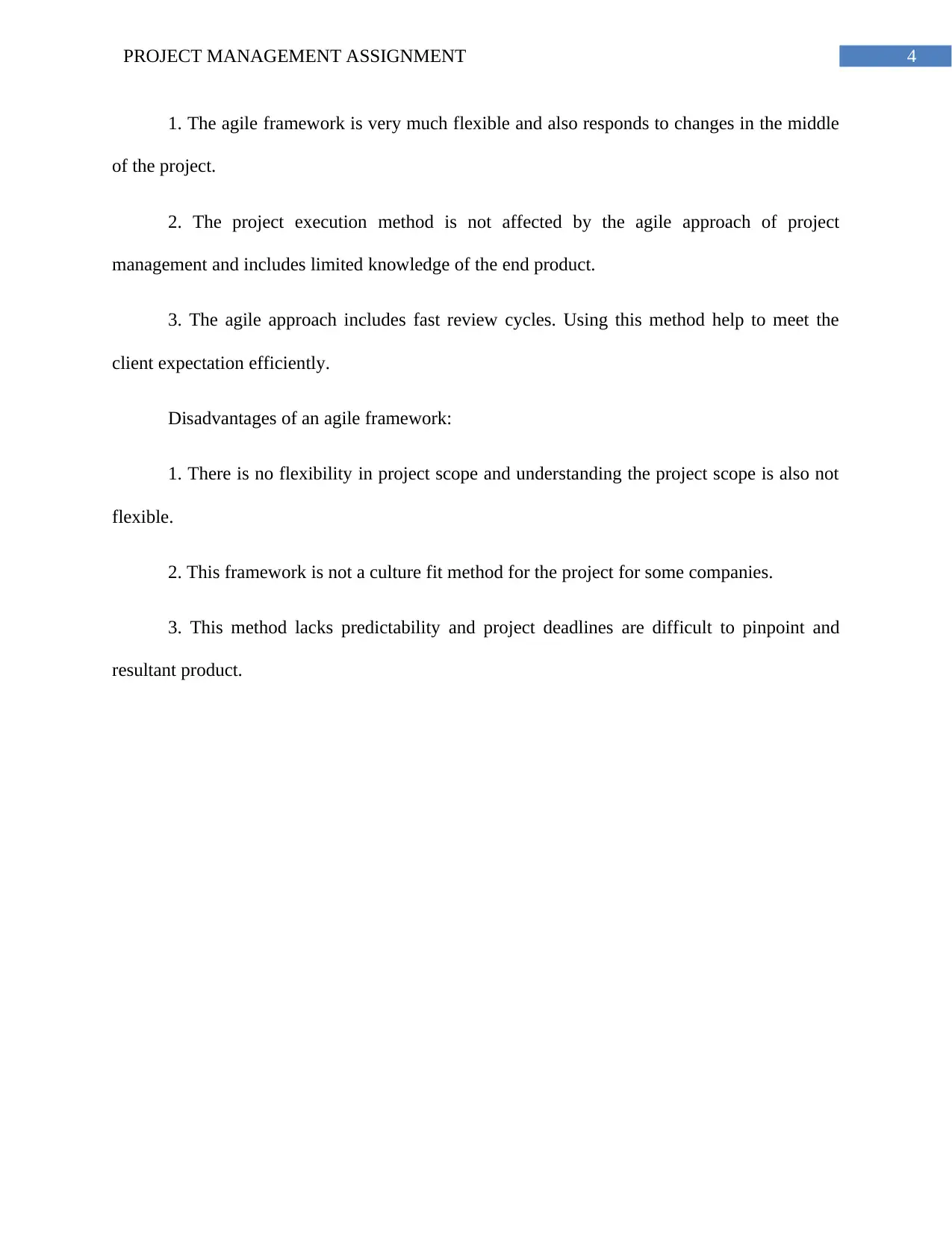
4PROJECT MANAGEMENT ASSIGNMENT
1. The agile framework is very much flexible and also responds to changes in the middle
of the project.
2. The project execution method is not affected by the agile approach of project
management and includes limited knowledge of the end product.
3. The agile approach includes fast review cycles. Using this method help to meet the
client expectation efficiently.
Disadvantages of an agile framework:
1. There is no flexibility in project scope and understanding the project scope is also not
flexible.
2. This framework is not a culture fit method for the project for some companies.
3. This method lacks predictability and project deadlines are difficult to pinpoint and
resultant product.
1. The agile framework is very much flexible and also responds to changes in the middle
of the project.
2. The project execution method is not affected by the agile approach of project
management and includes limited knowledge of the end product.
3. The agile approach includes fast review cycles. Using this method help to meet the
client expectation efficiently.
Disadvantages of an agile framework:
1. There is no flexibility in project scope and understanding the project scope is also not
flexible.
2. This framework is not a culture fit method for the project for some companies.
3. This method lacks predictability and project deadlines are difficult to pinpoint and
resultant product.
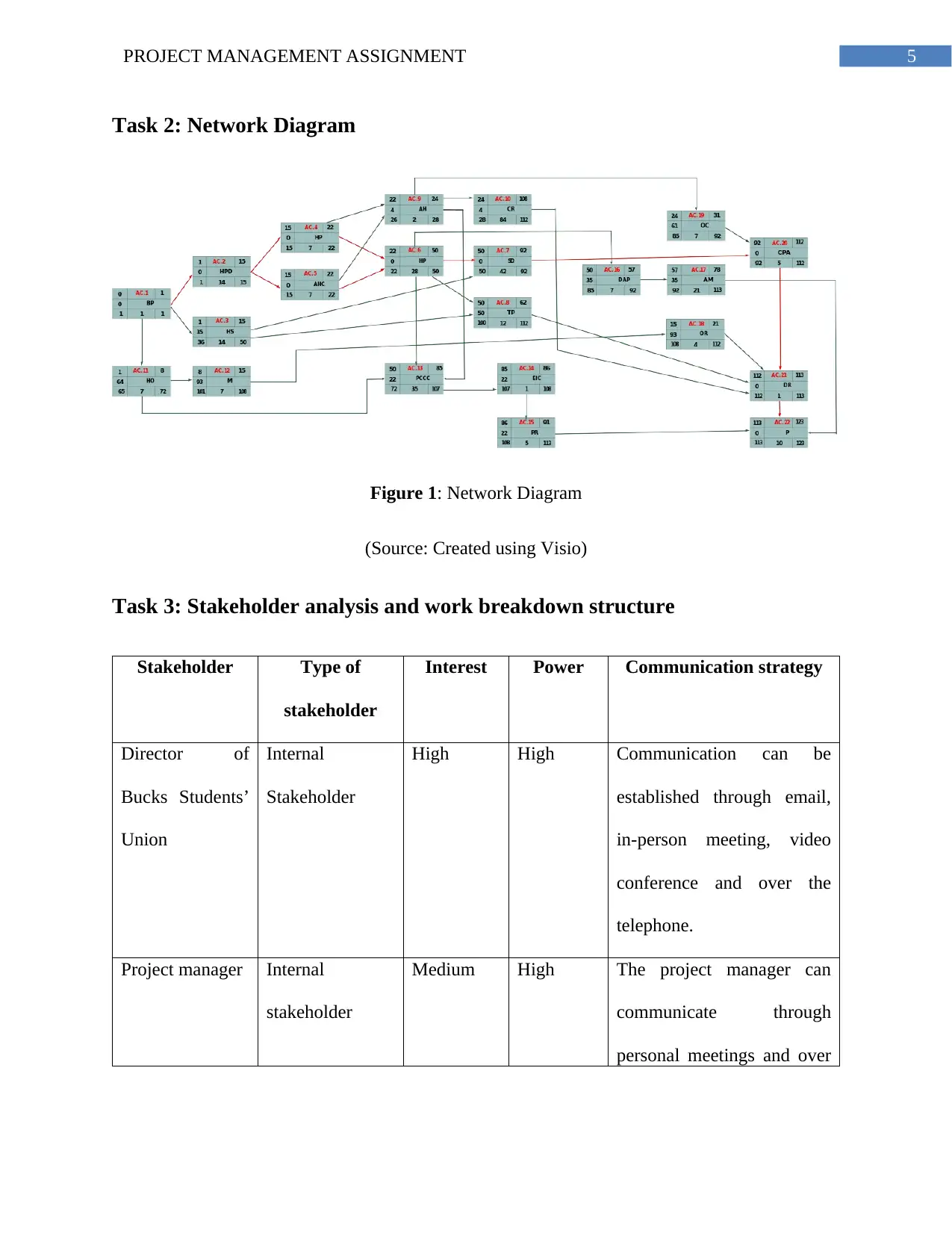
5PROJECT MANAGEMENT ASSIGNMENT
Task 2: Network Diagram
Figure 1: Network Diagram
(Source: Created using Visio)
Task 3: Stakeholder analysis and work breakdown structure
Stakeholder Type of
stakeholder
Interest Power Communication strategy
Director of
Bucks Students’
Union
Internal
Stakeholder
High High Communication can be
established through email,
in-person meeting, video
conference and over the
telephone.
Project manager Internal
stakeholder
Medium High The project manager can
communicate through
personal meetings and over
Task 2: Network Diagram
Figure 1: Network Diagram
(Source: Created using Visio)
Task 3: Stakeholder analysis and work breakdown structure
Stakeholder Type of
stakeholder
Interest Power Communication strategy
Director of
Bucks Students’
Union
Internal
Stakeholder
High High Communication can be
established through email,
in-person meeting, video
conference and over the
telephone.
Project manager Internal
stakeholder
Medium High The project manager can
communicate through
personal meetings and over
⊘ This is a preview!⊘
Do you want full access?
Subscribe today to unlock all pages.

Trusted by 1+ million students worldwide
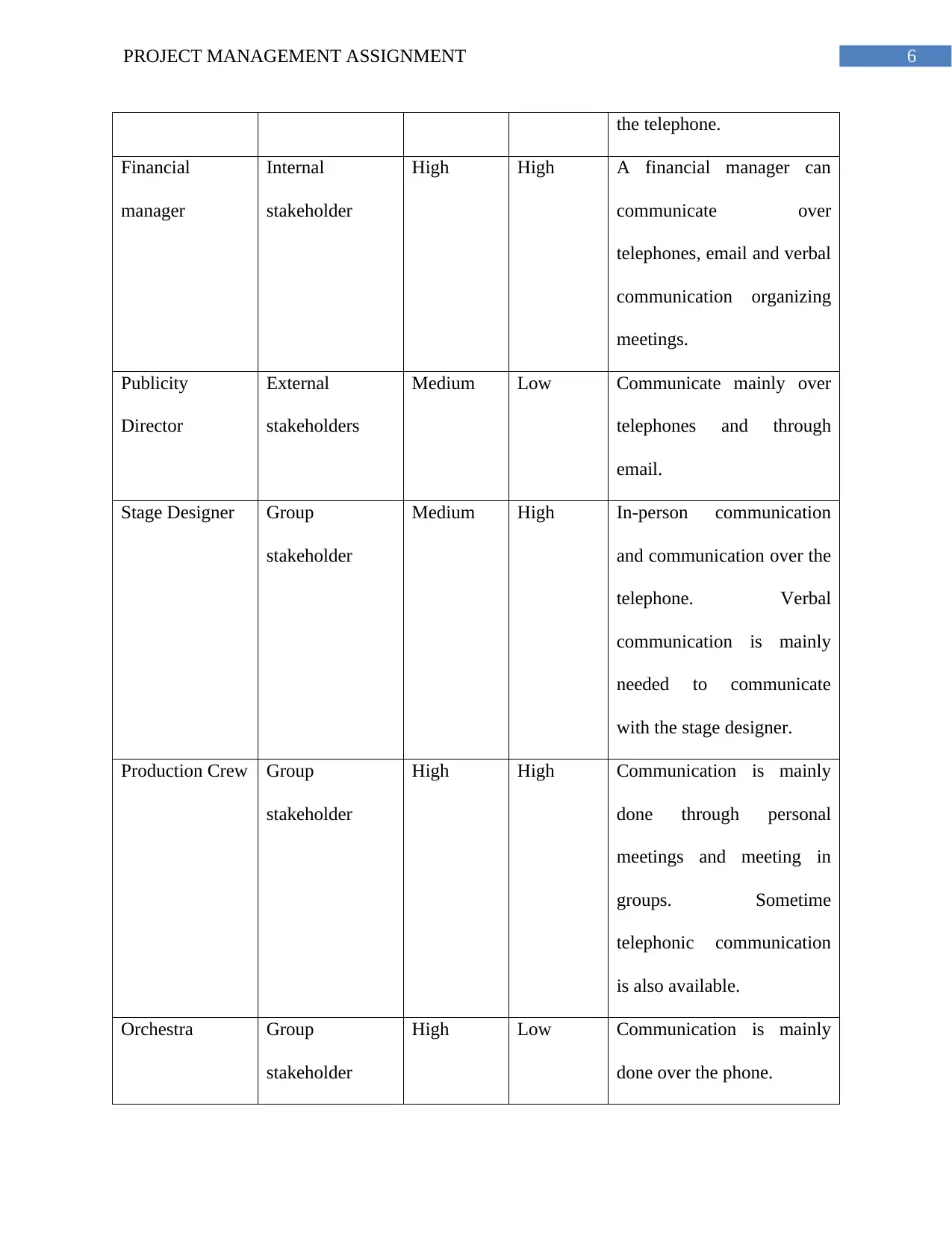
6PROJECT MANAGEMENT ASSIGNMENT
the telephone.
Financial
manager
Internal
stakeholder
High High A financial manager can
communicate over
telephones, email and verbal
communication organizing
meetings.
Publicity
Director
External
stakeholders
Medium Low Communicate mainly over
telephones and through
email.
Stage Designer Group
stakeholder
Medium High In-person communication
and communication over the
telephone. Verbal
communication is mainly
needed to communicate
with the stage designer.
Production Crew Group
stakeholder
High High Communication is mainly
done through personal
meetings and meeting in
groups. Sometime
telephonic communication
is also available.
Orchestra Group
stakeholder
High Low Communication is mainly
done over the phone.
the telephone.
Financial
manager
Internal
stakeholder
High High A financial manager can
communicate over
telephones, email and verbal
communication organizing
meetings.
Publicity
Director
External
stakeholders
Medium Low Communicate mainly over
telephones and through
email.
Stage Designer Group
stakeholder
Medium High In-person communication
and communication over the
telephone. Verbal
communication is mainly
needed to communicate
with the stage designer.
Production Crew Group
stakeholder
High High Communication is mainly
done through personal
meetings and meeting in
groups. Sometime
telephonic communication
is also available.
Orchestra Group
stakeholder
High Low Communication is mainly
done over the phone.
Paraphrase This Document
Need a fresh take? Get an instant paraphrase of this document with our AI Paraphraser
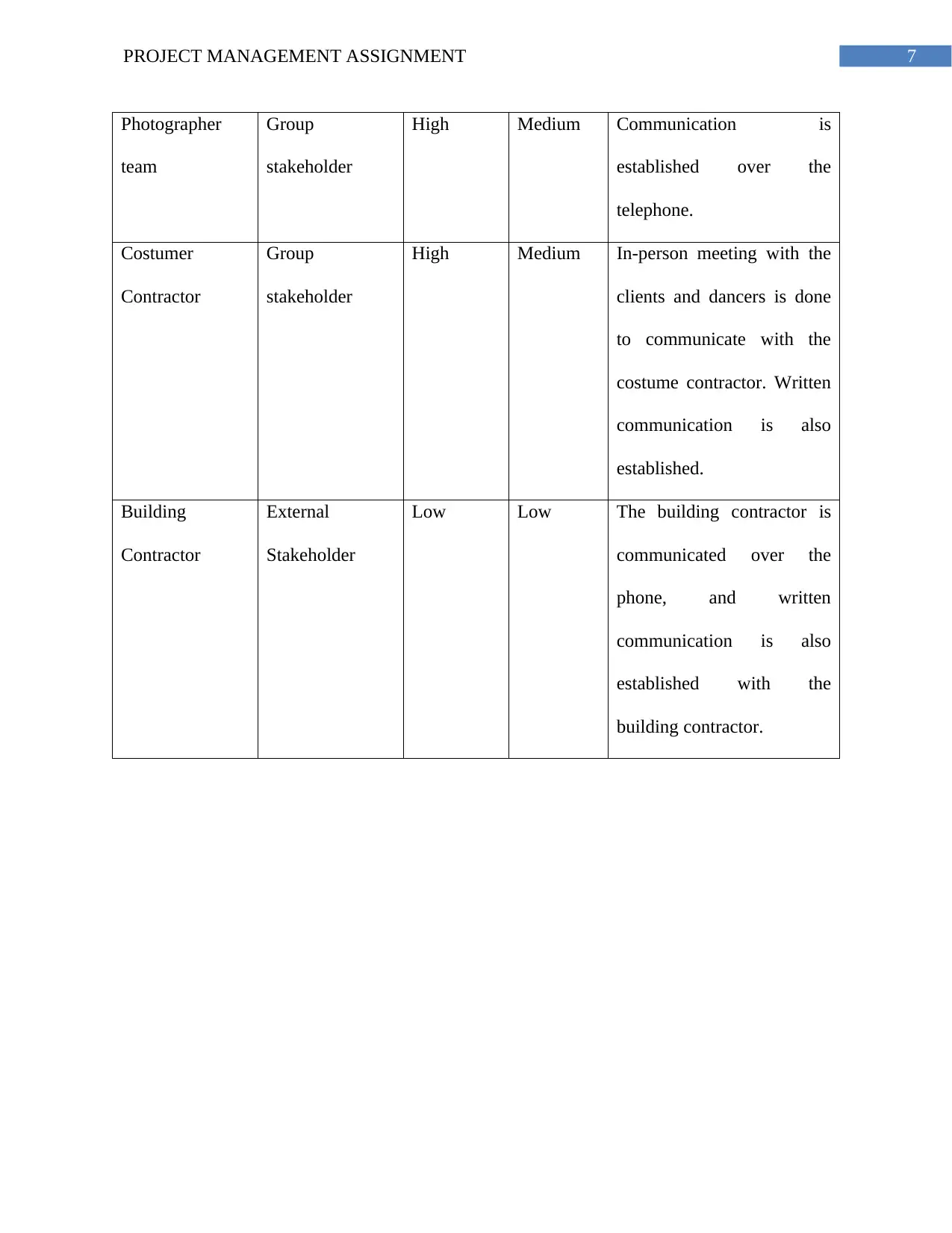
7PROJECT MANAGEMENT ASSIGNMENT
Photographer
team
Group
stakeholder
High Medium Communication is
established over the
telephone.
Costumer
Contractor
Group
stakeholder
High Medium In-person meeting with the
clients and dancers is done
to communicate with the
costume contractor. Written
communication is also
established.
Building
Contractor
External
Stakeholder
Low Low The building contractor is
communicated over the
phone, and written
communication is also
established with the
building contractor.
Photographer
team
Group
stakeholder
High Medium Communication is
established over the
telephone.
Costumer
Contractor
Group
stakeholder
High Medium In-person meeting with the
clients and dancers is done
to communicate with the
costume contractor. Written
communication is also
established.
Building
Contractor
External
Stakeholder
Low Low The building contractor is
communicated over the
phone, and written
communication is also
established with the
building contractor.
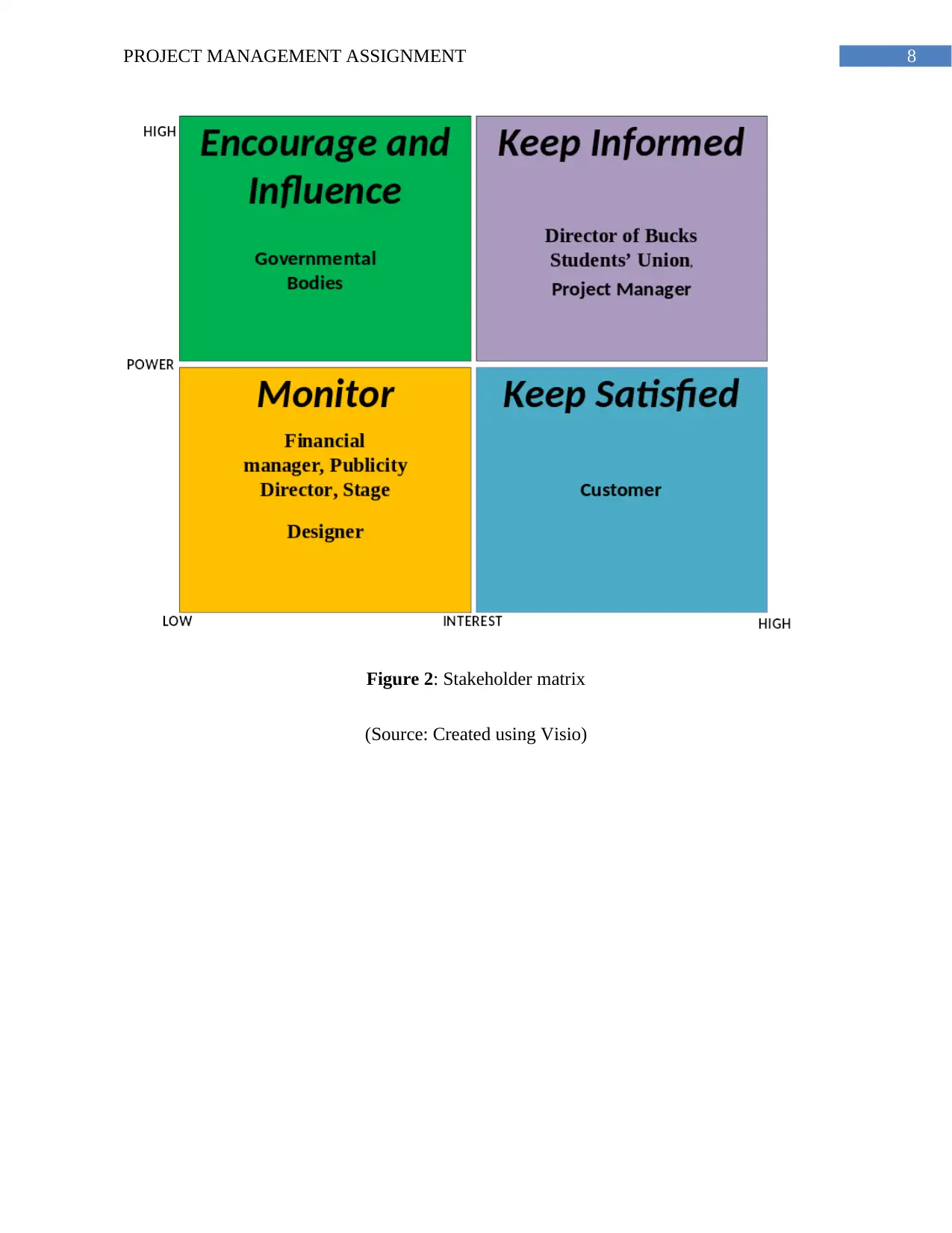
8PROJECT MANAGEMENT ASSIGNMENT
Figure 2: Stakeholder matrix
(Source: Created using Visio)
Figure 2: Stakeholder matrix
(Source: Created using Visio)
⊘ This is a preview!⊘
Do you want full access?
Subscribe today to unlock all pages.

Trusted by 1+ million students worldwide
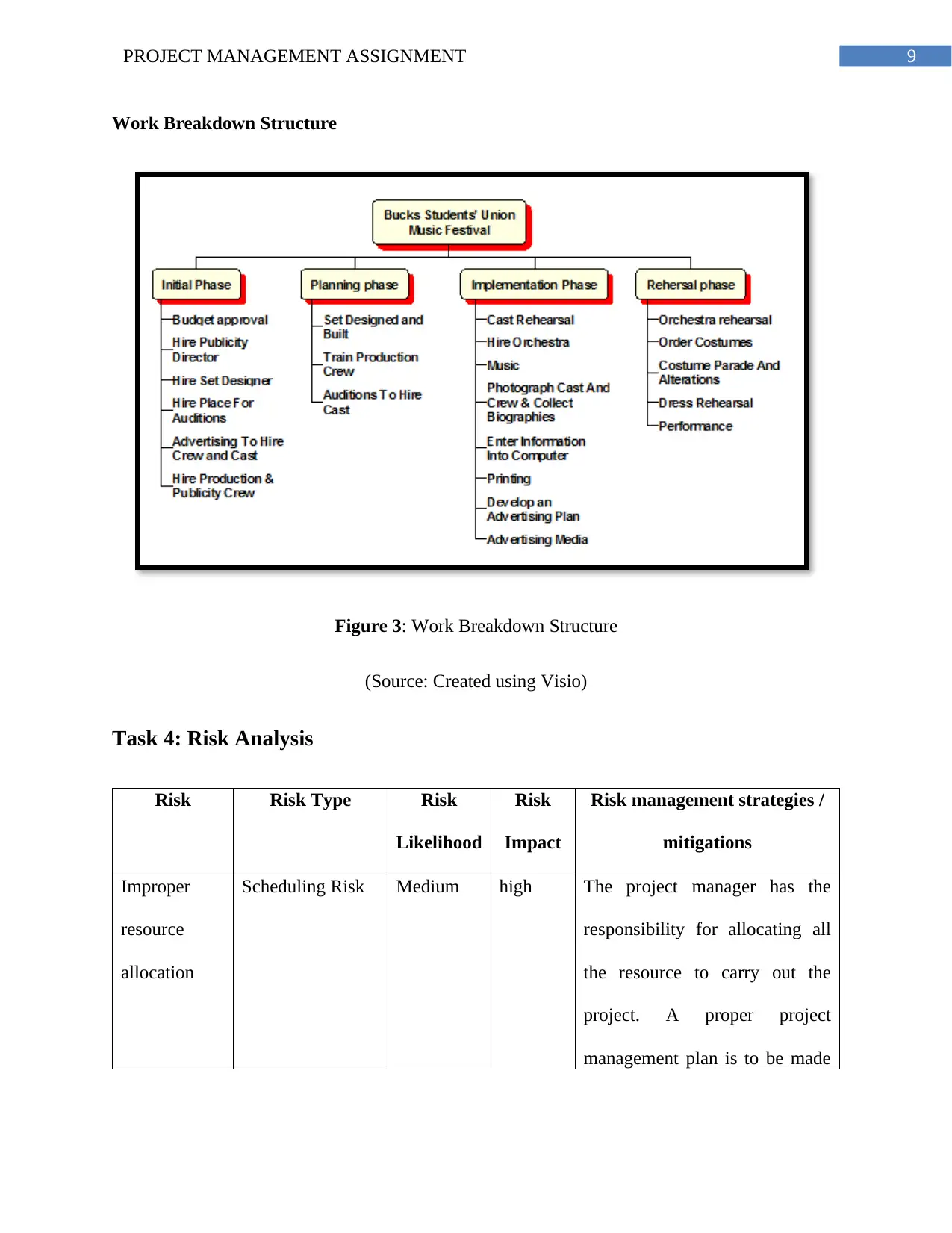
9PROJECT MANAGEMENT ASSIGNMENT
Work Breakdown Structure
Figure 3: Work Breakdown Structure
(Source: Created using Visio)
Task 4: Risk Analysis
Risk Risk Type Risk
Likelihood
Risk
Impact
Risk management strategies /
mitigations
Improper
resource
allocation
Scheduling Risk Medium high The project manager has the
responsibility for allocating all
the resource to carry out the
project. A proper project
management plan is to be made
Work Breakdown Structure
Figure 3: Work Breakdown Structure
(Source: Created using Visio)
Task 4: Risk Analysis
Risk Risk Type Risk
Likelihood
Risk
Impact
Risk management strategies /
mitigations
Improper
resource
allocation
Scheduling Risk Medium high The project manager has the
responsibility for allocating all
the resource to carry out the
project. A proper project
management plan is to be made
Paraphrase This Document
Need a fresh take? Get an instant paraphrase of this document with our AI Paraphraser
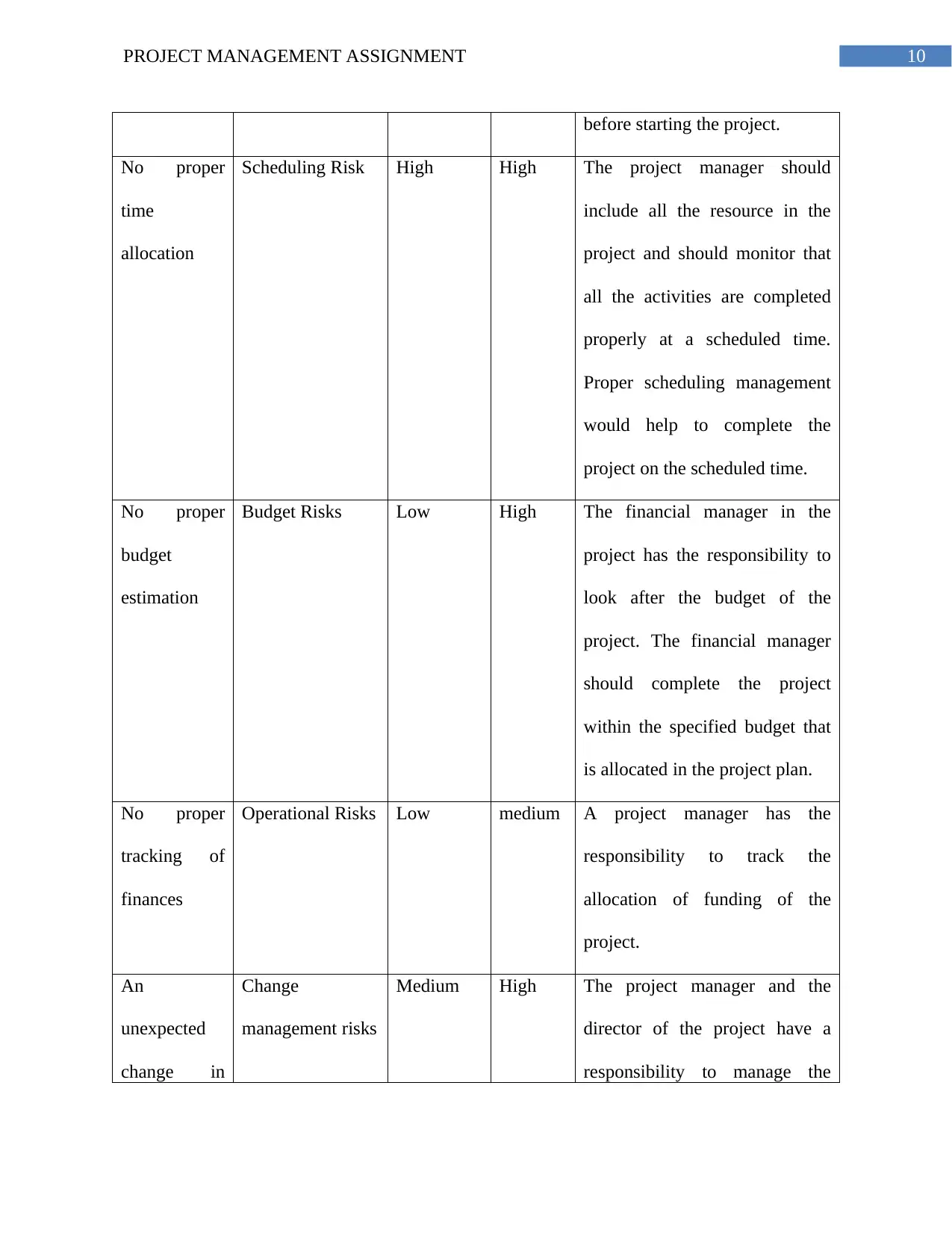
10PROJECT MANAGEMENT ASSIGNMENT
before starting the project.
No proper
time
allocation
Scheduling Risk High High The project manager should
include all the resource in the
project and should monitor that
all the activities are completed
properly at a scheduled time.
Proper scheduling management
would help to complete the
project on the scheduled time.
No proper
budget
estimation
Budget Risks Low High The financial manager in the
project has the responsibility to
look after the budget of the
project. The financial manager
should complete the project
within the specified budget that
is allocated in the project plan.
No proper
tracking of
finances
Operational Risks Low medium A project manager has the
responsibility to track the
allocation of funding of the
project.
An
unexpected
change in
Change
management risks
Medium High The project manager and the
director of the project have a
responsibility to manage the
before starting the project.
No proper
time
allocation
Scheduling Risk High High The project manager should
include all the resource in the
project and should monitor that
all the activities are completed
properly at a scheduled time.
Proper scheduling management
would help to complete the
project on the scheduled time.
No proper
budget
estimation
Budget Risks Low High The financial manager in the
project has the responsibility to
look after the budget of the
project. The financial manager
should complete the project
within the specified budget that
is allocated in the project plan.
No proper
tracking of
finances
Operational Risks Low medium A project manager has the
responsibility to track the
allocation of funding of the
project.
An
unexpected
change in
Change
management risks
Medium High The project manager and the
director of the project have a
responsibility to manage the
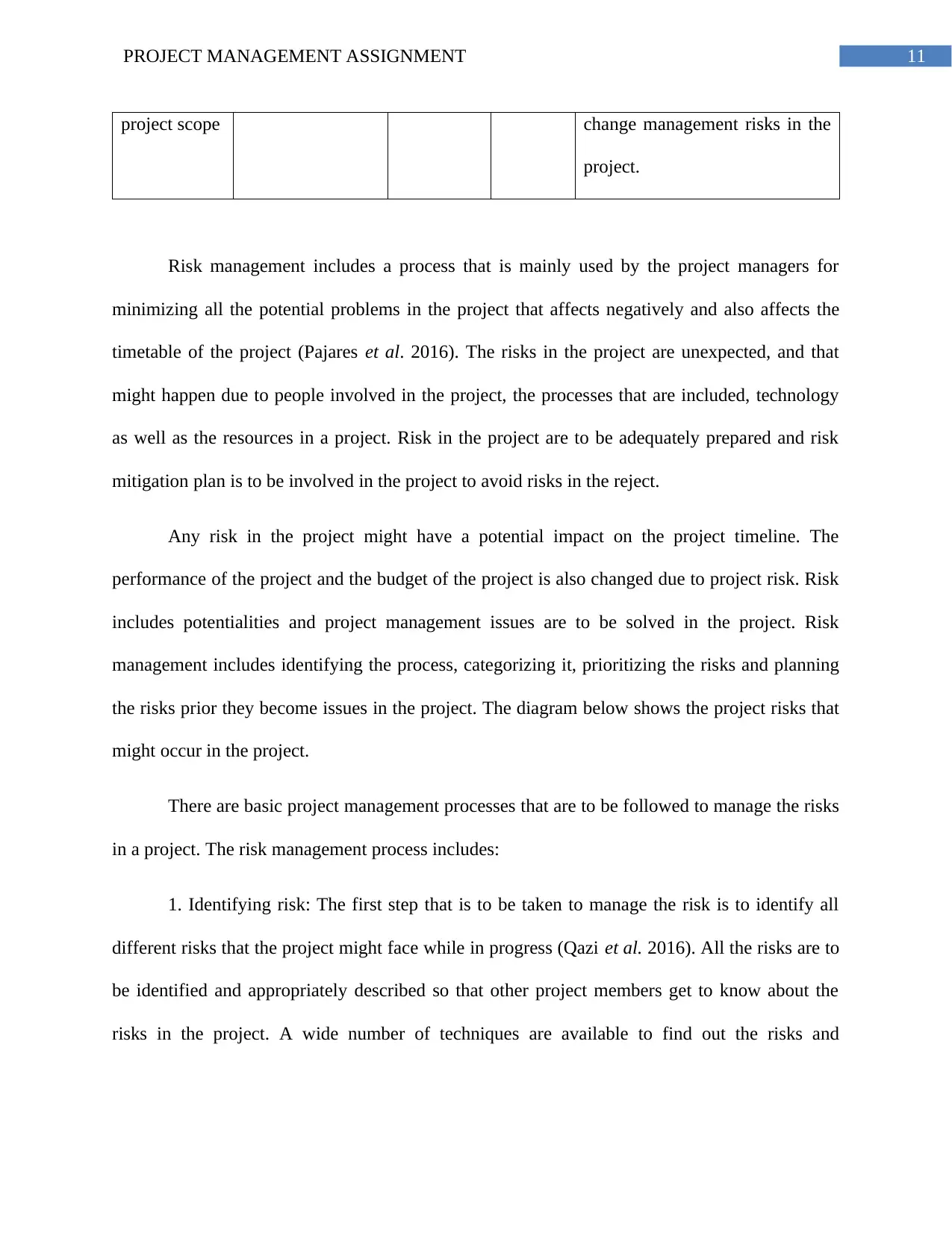
11PROJECT MANAGEMENT ASSIGNMENT
project scope change management risks in the
project.
Risk management includes a process that is mainly used by the project managers for
minimizing all the potential problems in the project that affects negatively and also affects the
timetable of the project (Pajares et al. 2016). The risks in the project are unexpected, and that
might happen due to people involved in the project, the processes that are included, technology
as well as the resources in a project. Risk in the project are to be adequately prepared and risk
mitigation plan is to be involved in the project to avoid risks in the reject.
Any risk in the project might have a potential impact on the project timeline. The
performance of the project and the budget of the project is also changed due to project risk. Risk
includes potentialities and project management issues are to be solved in the project. Risk
management includes identifying the process, categorizing it, prioritizing the risks and planning
the risks prior they become issues in the project. The diagram below shows the project risks that
might occur in the project.
There are basic project management processes that are to be followed to manage the risks
in a project. The risk management process includes:
1. Identifying risk: The first step that is to be taken to manage the risk is to identify all
different risks that the project might face while in progress (Qazi et al. 2016). All the risks are to
be identified and appropriately described so that other project members get to know about the
risks in the project. A wide number of techniques are available to find out the risks and
project scope change management risks in the
project.
Risk management includes a process that is mainly used by the project managers for
minimizing all the potential problems in the project that affects negatively and also affects the
timetable of the project (Pajares et al. 2016). The risks in the project are unexpected, and that
might happen due to people involved in the project, the processes that are included, technology
as well as the resources in a project. Risk in the project are to be adequately prepared and risk
mitigation plan is to be involved in the project to avoid risks in the reject.
Any risk in the project might have a potential impact on the project timeline. The
performance of the project and the budget of the project is also changed due to project risk. Risk
includes potentialities and project management issues are to be solved in the project. Risk
management includes identifying the process, categorizing it, prioritizing the risks and planning
the risks prior they become issues in the project. The diagram below shows the project risks that
might occur in the project.
There are basic project management processes that are to be followed to manage the risks
in a project. The risk management process includes:
1. Identifying risk: The first step that is to be taken to manage the risk is to identify all
different risks that the project might face while in progress (Qazi et al. 2016). All the risks are to
be identified and appropriately described so that other project members get to know about the
risks in the project. A wide number of techniques are available to find out the risks and
⊘ This is a preview!⊘
Do you want full access?
Subscribe today to unlock all pages.

Trusted by 1+ million students worldwide
1 out of 16
Related Documents
Your All-in-One AI-Powered Toolkit for Academic Success.
+13062052269
info@desklib.com
Available 24*7 on WhatsApp / Email
![[object Object]](/_next/static/media/star-bottom.7253800d.svg)
Unlock your academic potential
Copyright © 2020–2025 A2Z Services. All Rights Reserved. Developed and managed by ZUCOL.





